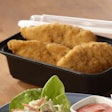As the days are getting shorter, the temperatures are getting colder including the northern parts of the world. The cold itself wouldn’t be that much of a problem for the adult birds, but the humidity that goes along with it might cause some troubles, especially in relation to respiratory problems. When the cold air enters the barn, it can fall rapidly to the floor and displace the warm air. It is a negative spiral as this cold air is not able to absorb the excessive humidity and then the litter might get caked. When litter gets caked, higher amounts of ammonia and carbon dioxide are developed, and this may cause inflammation of the respiratory tract and cause respiratory problems. In younger birds it might cause enteritis because the gut is chilled by the contact of the cold and humid litter. In order to overcome these problems the usage of a heating system along with proper ventilation is highly recommended.
When temperature drops, feed intake will be increased in order for the birds to fulfill their energy requirements to produce extra heat. But as feed intake is so highly correlated with egg size, you can expect an increase in egg size of the eggs produced by your birds. The egg size can be managed via the diet specifications; do not hesitate to contact the ISA nutritionists in case of any questions.
In direct correlation with feed intake is the birds’ feather cover, a proper feather cover will improve the birds’ thermal balance. The feed intake of birds with intact feather cover will be lower compared to birds with impaired feather cover. Observing the behavior of the flocks daily is important, so you will learn about the birds needs and changes can be implemented in time to overcome excessive damage to the birds.
As proper water supply is one of the key factors to maintain flocks in a healthy and viable condition, extra attentions must be paid to water pipes, which might freeze when temperatures are low for a longer period of time.
However, most of the success starts with a good start, such as making sure barn houses are properly warmed when new birds arrive. That allows birds to adapt and feel comfortable from day one. It will reduce the risk of smothering; the birds tend to smother in order to stay warm when it gets too cold in the barn.














